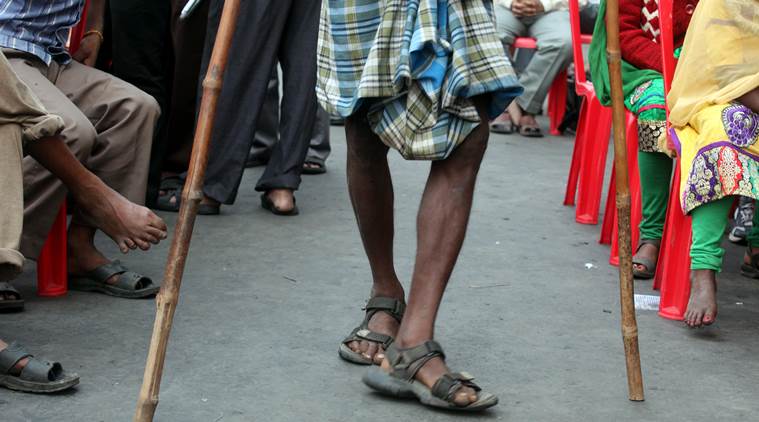- India
- International
The Invisible People
Government must ensure the disabilities law reaches out to the most needy.
 The greater visibility of persons with disabilities in public has brought about a noticeable change in the attitude of non-disabled citizens. (Express photo by: Partha Paul)
The greater visibility of persons with disabilities in public has brought about a noticeable change in the attitude of non-disabled citizens. (Express photo by: Partha Paul)
The Persons with Disabilities (Equal Opportunities, Protection of Rights and Full Participation) Act, 1995, (PWDA) completed two decades of existence this month. However, the majority of disabled people is yet to avail the entitlements envisaged under the law. Inaccessible public places, non-accommodative educational institutions and the lack of employment opportunities for the disabled are widespread. Under Section 33 of the PWDA, it is mandatory for the government to provide 3 per cent reservation to the disabled in public employment. It also calls upon Central and state governments to establish special employment exchanges to facilitate easy and hassle-free placement for eligible disabled candidates. However, implementation has been weak. The majority of state governments, such as Bihar, Maharashtra, Madhya Pradesh, Rajasthan and Uttar Pradesh, which account for the largest proportion of the disabled, are biased against employing educated disabled candidates.
Governments at the Centre and in the states did set up several employment exchanges and conduct special recruitment drives, but the required 3 per cent reservation is still far from being implemented in many departments. According to the RTI response published by The Indian Express on December 3, 2013 (‘Disabled have 3% quota in govt jobs, but add up to only 0.12%’), “out of over 24 lakh employees belonging to group A, B and C, the total number of persons employed from disabled category was merely 5,014 on January 1, 2012”. The report further stated, “140 disabled category people were employed in group A, where total number of such employees is around 77,000. On the other hand, out of around 1.90 lakh employees of group B category, only 712 were from disabled category. Similarly, the representation of disabled people in around 22.60 lakh employees of group C category was merely 4,162.” Thus, the percentage of disabled employees in groups A, B and C was 0.18, 0.37 and 0.18 per cent respectively. Data for group D was not provided.
This is a grave issue, especially in several states where no research is undertaken to ascertain the woes of the disabled. The tardy implementation of the employment provision and absence of any penal provision for those who violate the PWDA is a serious lacuna. Still, although the PWDA is marred by loopholes, its existence has ushered in a new wave of advocacy and activism. A number of NGOs have sprouted to fight for the rights of disabled people. Several public interest litigations (PILs) were filed in high courts and the apex court to demand the implementation of provisions under the PWDA. The Supreme Court, in its landmark judgment on October 8, 2013, had reprimanded the Indian state for not abiding by the law and consigning millions of disabled to the margins. Thus, owing to the judiciary’s intervention and progressive interpretation of the law, the embarrassed Central government has committed itself to fulfilling the quota by February 2016. But the larger hurdle is posed by states, where the bureaucracy is not aware of the law.
Despite the PWDA’s weak implementation, it has empowered some among the disabled. They have attained respectful employment. The greater visibility of persons with disabilities in the public domain has brought about a noticeable change in the attitude of non-disabled citizens about the capabilities of such persons, which shows the PWDA has allowed disabled people to seek dignified livelihoods hard to come by earlier. But most people who got jobs under the 3 per cent provision live in urban areas, although, according to Census 2011, more than 60 per cent of disabled people live in the countryside. The PWDA’s fruits have not percolated to the most marginalised among the disabled.
Disabled women, SCs and STs in rural India are still at the margins, with most still dependent on family members for survival. Government services and information related to welfare schemes and educational and employment opportunities hardly reach them. Therefore, governments at the Centre and in states need to focus on how to reach persons with disabilities in rural India. Sufficient financial allocation and strict monitoring of the PWDA’s implementation can empower the disabled in a substantive sense.
EXPRESS OPINION
More Explained
Apr 25: Latest News
- 01
- 02
- 03
- 04
- 05










































